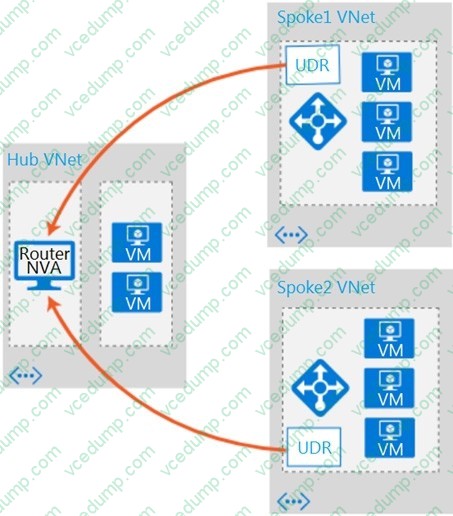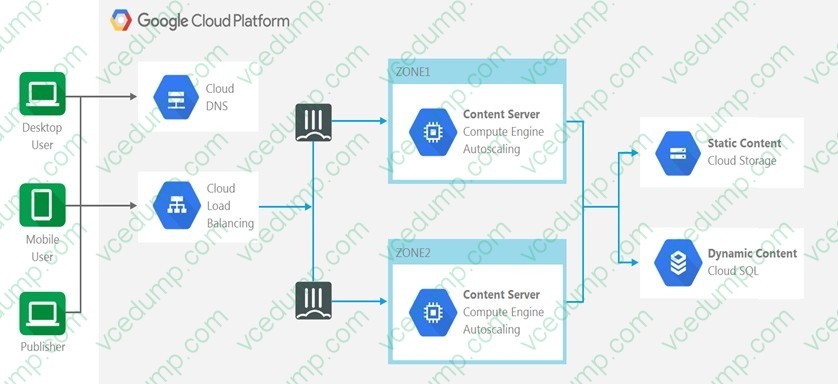NSE7_PBC-6.4 Exam Details
-
Exam Code
:NSE7_PBC-6.4 -
Exam Name
:Fortinet NSE 7 - Public Cloud Security 6.4 -
Certification
:Fortinet Certifications -
Vendor
:Fortinet -
Total Questions
:30 Q&As -
Last Updated
:Jan 14, 2026
Fortinet NSE7_PBC-6.4 Online Questions & Answers
-
Question 1:
You need to deploy FortiGate VM devices in a highly available topology in the Microsoft Azure cloud. The following are the requirements of your deployment:
Two FortiGate devices must be deployed; each in a different availability zone.
Each FortiGate requires two virtual network interfaces: one will connect to a public subnet and the other will connect to a private subnet.
An external Microsoft Azure load balancer will distribute ingress traffic to both FortiGate devices in an active-active topology.
An internal Microsoft Azure load balancer will distribute egress traffic from protected virtual machines to both FortiGate devices in an active-active topology.
Traffic should be accepted or denied by a firewall policy in the same way by either FortiGate device in this topology.
Which FortiOS CLI configuration can help reduce the administrative effort required to maintain the FortiGate devices, by synchronizing firewall policy and object configuration between the FortiGate devices?
A. config system sdn-connector
B. config system ha
C. config system auto-scale
D. config system session-sync -
Question 2:
Customer XYZ has an ExpressRoute connection from Microsoft Azure to a data center. They want to secure communication over ExpressRoute, and to install an in-line FortiGate to perform intrusion prevention system (IPS) and antivirus scanning.
Which three methods can the customer use to ensure that all traffic from the data center is sent through FortiGate over ExpressRoute? (Choose three.)
A. Install FortiGate in Azure and build a VPN tunnel to the data center over ExpressRoute
B. Configure a user-defined route table
C. Enable the redirect option in ExpressRoute to send data center traffic to a user-defined route table
D. Configure the gateway subnet as the subnet in the user-defined route table
E. Define a default route where the next hop IP is the FortiGate WAN interface -
Question 3:

Refer to the exhibit. You are configuring an active-passive FortiGate clustering protocol (FGCP) HA configuration in a single availability zone in Amazon Web Services (AWS), using a cloud formation template.
After deploying the template, you notice that the AWS console has IP information listed in the FortiGate VM firewalls in the HA configuration. However, within the configuration of FortiOS, you notice that port1 is using an IP of 10.0.0.13, and
port2 is using an IP of 10.0.1.13.
What should you do to correct this issue?
A. Configure FortiOS to use static IP addresses with the IP addresses reflected in the ENI primary IP address configuration (as per the exhibit).
B. Delete the deployment and start again. You have in put the wrong parameters during the cloud formation template deployment.
C. Configure FortiOS to use DHCP so that it will get the correct IP addresses on the ports.
D. Nothing, in AWS cloud, it is normal for a FortiGate ENI primary IP address to be different than the FortiOS IP address configuration. -
Question 4:
Which statement about FortiSandbox in Amazon Web Services (AWS) is true?
A. In AWS, virtual machines (VMs) that inspect files do not have to be reset after inspecting a file.
B. FortiSandbox in AWS uses Windows virtual machines (VMs) to inspect files.
C. In AWS, virtual machines (VMs) that inspect files are constantly up and running.
D. FortiSandbox in AWS can have a maximum of eight virtual machines (VMs) that inspect files. -
Question 5:
You have been asked to develop an Azure Resource Manager infrastructure as a code template for the FortiGate-VM, that can be reused for multiple deployments. The deployment fails, and errors point to the storageAccount name. Which two are restrictions for a storageAccount name in an Azure Resource Manager template? (Choose two.)
A. The uniqueString() function must be used.
B. The storageAccount name must use special characters.
C. The storageAccount name must be in lowercase.
D. The storageAccount name must contain between 3 and 24 alphanumeric characters. -
Question 6:
An organization deployed a FortiGate-VM in the Google Cloud Platform and initially configured it with two vNICs. Now, the same organization wants to add additional vNICs to this existing FortiGate-VM to support different workloads in their environment.
How can they do this?
A. They can create additional vNICs using the Cloud Shell.
B. They cannot create and add additional vNICs to an existing FortiGate-VM.
C. They can create additional vNICs in the UI console.
D. They can use the Compute Engine API Explorer. -
Question 7:

Refer to the exhibit. Which two conditions will enable you to segregate and secure the traffic between the hub and the spokes in Microsoft Azure? (Choose two.)
A. Implement the FortiGate-VM network virtual appliance (NVA) in the hub and use user-defined routes (UDRs) in the spokes.
B. Use ExpressRoute to interconnect the hub VNets and spoke VNets.
C. Configure VNet peering between the spokes only.
D. Configure VNet peering between the hub and spokes. -
Question 8:

Refer to the exhibit. The exhibit shows a topology where multiple connections from clients to the same FortiGate-VM instance, regardless of the protocol being used, are required. Which two statements are correct? (Choose two.)
A. The design shows an active-active FortiGate-VM architecture.
B. The Cloud Load Balancer Session Affinity setting should be changed to CLIENT_IP.
C. The design shows an active-passive FortiGate-VM architecture.
D. The Cloud Load Balancer Session Affinity setting should use the default value. -
Question 9:
An organization deploys a FortiGate-VM (VM04 / c4.xlarge) in Amazon Web Services (AWS) and configures two elastic network interfaces (ENIs). Now, the same organization wants to add additional ENIs to support different workloads in their environment.
Which action can you take to accomplish this?
A. None, you cannot create and add additional ENIs to an existing FortiGate-VM.
B. Create the ENI, shut down FortiGate, attach the ENI to FortiGate, and then start FortiGate.
C. Create the ENI, attach it to FortiGate, and then restart FortiGate.
D. Create the ENI and attach it to FortiGate. -
Question 10:
Which two statements about Amazon Web Services (AWS) networking are correct? (Choose two.)
A. Proxy ARP entries are disregarded.
B. 802.1q VLAN tags are allowed inside the same virtual private cloud.
C. AWS DNS reserves the first host IP address of each subnet.
D. Multicast traffic is not allowed.
Related Exams:
-
EMEA-ADVANCED-SUPPORT
Fortinet EMEA Advanced Support -
FCP_FAC_AD-6.5
FCP - FortiAuthenticator 6.5 Administrator -
FCP_FAZ_AD-7.4
FCP - FortiAnalyzer 7.4 Administrator -
FCP_FAZ_AN-7.4
FCP - FortiAnalyzer 7.4 Analyst -
FCP_FCT_AD-7.2
FCP - Forti Client EMS 7.2 Administrator -
FCP_FGT_AD-7.4
FCP - FortiGate 7.4 Administrator -
FCP_FGT_AD-7.6
FortiGate 7.6 Administrator FCP_FGT_AD-7.6 -
FCP_FMG_AD-7.4
FCP - FortiManager 7.4 Administrator -
FCP_FMG_AD-7.6
FortiManager 7.6 Administrator -
FCP_FML_AD-7.4
FCP - FortiMail 7.4 Administrator
Tips on How to Prepare for the Exams
Nowadays, the certification exams become more and more important and required by more and more enterprises when applying for a job. But how to prepare for the exam effectively? How to prepare for the exam in a short time with less efforts? How to get a ideal result and how to find the most reliable resources? Here on Vcedump.com, you will find all the answers. Vcedump.com provide not only Fortinet exam questions, answers and explanations but also complete assistance on your exam preparation and certification application. If you are confused on your NSE7_PBC-6.4 exam preparations and Fortinet certification application, do not hesitate to visit our Vcedump.com to find your solutions here.